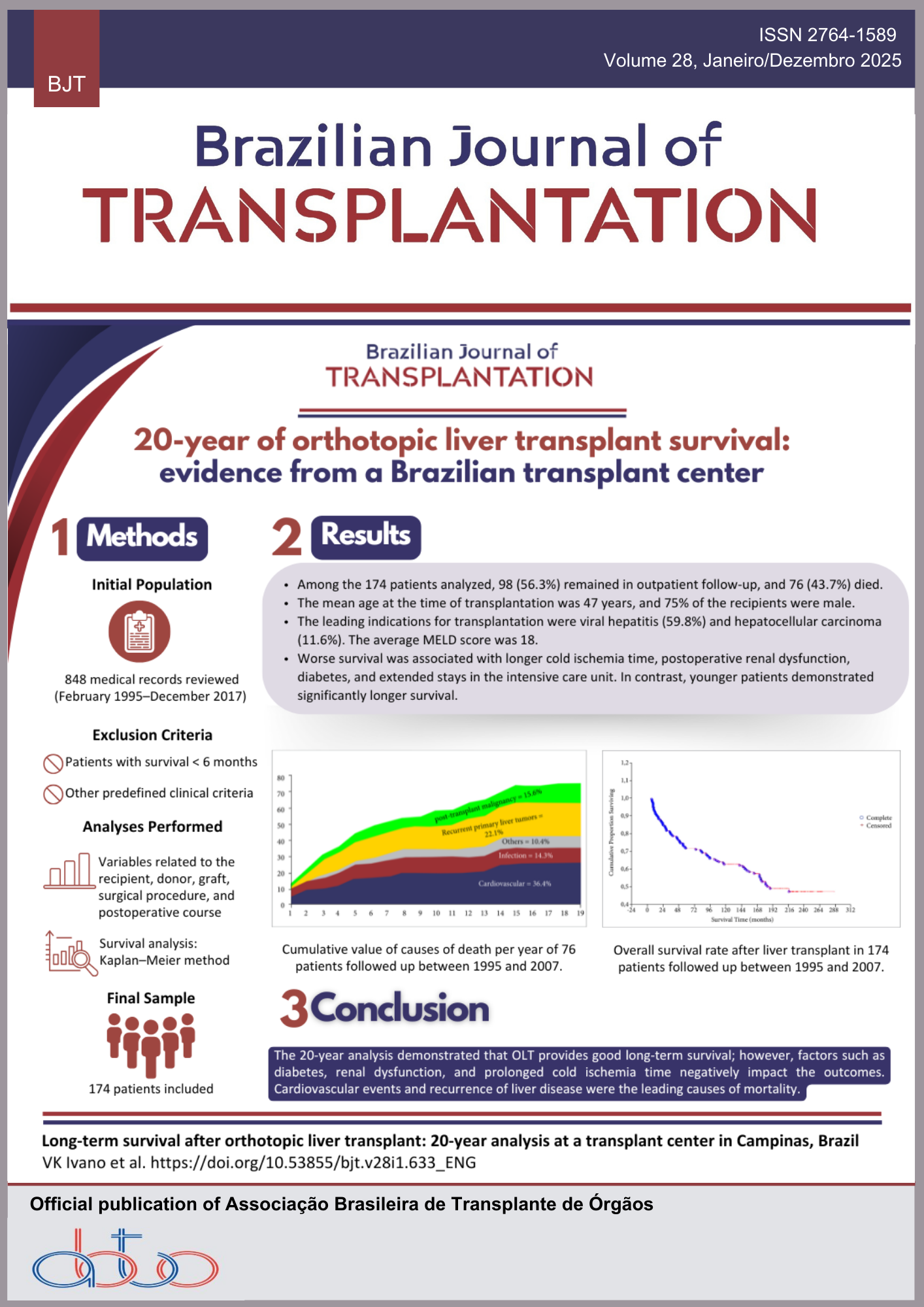Use of Aortohepatic Conduit in Liver Transplantation: Experience of Two Decades
Keywords:
Liver Transplantation, Vascular Graft, Vascular Surgical ProceduresAbstract
Introduction: Aortohepatic conduits (AHC) are an alternative for graft revascularization when conventional arterial anastomosis is not feasible. They are usually made from the donor iliac artery and anastomosed to the infrarenal or supraceliac aorta. Although essential in some cases, the results in the literature are conflicting. Objectives: To analyze the outcomes of the graft and patients undergoing primary liver transplantation (LTx) or retransplantation with aortohepatic conduits over 24 years. Methods: This is a retrospective and observational study analyzing medical records of patients who underwent LTx by a Brazilian team from 2000 to 2024. Patients aged 12 years or older who underwent revascularization using an aortohepatic conduit were included. Data on donors, recipients, surgical techniques, and intra- and postoperative outcomes were collected. Results: 1.799 LTx procedures were performed during the study period, 43 used arterial conduits, and 41 were included in the final analysis. Most patients were male, with a mean age of 39.24 years. Among the 41 transplants, 17 were primary, and 24 were retransplants. All conduits were made with grafts from donor iliac and/or carotid arteries. The main indications for their use were arterial thrombosis and dissection or friability of the vascular intima. The mean hospital stay was 13 days, and the mean overall survival was 38.51 months. Postoperative complications included arterial thrombosis and biliary complications. Conclusion: Aortohepatic conduits in LTx are a life-saving strategy in specific cases despite the increased risk of arterial thrombosis and biliary complications. Endovascular intervention shows promise, but prospective studies are needed to define the ideal anastomosis site, assess its impact on survival, and determine the role of antiplatelet therapy in this context.
Downloads
References
1. Meirelles Júnior RF, Salvalaggio P, Rezende MB, Evangelista A, Guardia B, Lourenço C, et al. Liver transplantation: history, outcomes and perspectives. Einstein, 2015; 13: 149. https://doi.org/10.1590/S1679-45082015RW3164
2. Chatzizacharias NA, Aly M, Praseedom RK. The role of arterial conduits for revascularisation in adult orthotopic liver transplantation. Transplant Rev, 2017; 31: 121-66. https://doi.org/10.1016/j.trre.2016.10.008
3. Vivarelli M, Benedetti Cacciaguerra A, Lerut J, Lanari J, Conte G, Pravisani R, et al. Infrarenal versus supraceliac aortohepatic arterial revascularisation in adult liver transplantation: multicentre retrospective study. Updates Surg, 2020; 72: 659-69. https://doi.org/10.1007/s13304-020-00839-x
4. Reese T, Raptis DA, Oberkofler CE, Dutkowski P, Clavien P, Petrowsky H, et al. A systematic review and meta-analysis of rescue revascularization with arterial conduits in liver transplantation. Am J Transplant, 2019; 19: 551-63. https://doi.org/10.1111/ajt.15018
5. Hibi T, Nishida S, Levi DM, Daisuke S, Kyota F, Akin T, et al. Long-term deleterious effects of aortohepatic conduits in primary liver transplantation: proceed with caution. Liver Transpl, 2013; 19: 916-25. https://doi.org/10.1002/lt.23689
6. Nikitin D, Jennings LW, Khan T, Sanchez E, Chinnakotla S, Randall H, et al. Twenty years of follow-up of aortohepatic conduits in liver transplantation. Liver Transpl, 2008; 14: 1486-90. https://doi.org/10.1002/lt.21575
7. Jung DH, Park CS, Ha TY, Song FW, Park GC, Cho YP, et al. Placement of an aortohepatic conduit as an alternative to standard arterial anastomosis in liver transplantation. Ann Transplant, 2018; 23: 61. https://doi.org/10.12659/AOT.906307
8. Nunes RL, Cristina De Ataide E, Garcia MS, Perales S, Stucch R, et al. Interposição de enxerto ilíaco de doador para revascularização de implantes em transplante ortotópico de fígado: descrição da casuística em 745 transplantes realizados e revisão da literatura. Braz J Transpl, 2015; 18: 112-6. https://doi.org/10.53855/bjt.v18i4.134
9. Oberkofler CE, Raptis DA, Dinorcia J, Kaldas F, Muller P, Pita A, et al. How to handle arterial conduits in liver transplantation? Evidence from the first multicenter risk analysis. Ann Surg, 2021; 274: 1032-42. https://doi.org/10.1097/SLA.0000000000003753
10. Shaw BW, Iwatsuki S, Starzl TE. Alternative methods of arterialization of the hepatic graft. Surg Gynecol Obstet, 1984;159: 490.
11. Muiesan P, Rela M, Nodari F, Melendez V, Smyrniotis V, Vougas V, et al. Use of infrarenal conduits for arterial revascularization in orthotopic liver transplantation. Liver Transpl Surg, 1998; 4: 232-5. https://doi.org/10.1002/lt.500040314
12. Tovoli F, Vannini A, Fusconi M, Frisoni M, Zauli D. Autoimmune liver disorders and small-vessel vasculitis: four case reports and review of the literature. Ann Hepatol, 2014; 13: 136-41. https://doi.org/10.1016/S1665-2681(19)30915-9
13. Ruiz P, Sastre L, Crespo G, Blasé A, colmenero J, BAldecasas J, et al. Increased risk of portal vein thrombosis in patients with autoimmune hepatitis on the liver transplantation waiting list. Clin Transplant, 2017; 31: e13001. https://doi.org/10.1111/ctr.13001
14. Denecke C, Weiss S, Biebl M, Fritz J, Dziodzo T, Aigner F, et al. An arterial conduit is not a risk factor for survival following orthotropic liver transplantation: an analysis of 20 years of liver transplantation in Innsbruck. Ann Transplant, 2016; 21: 321-8. https://doi.org/10.12659/AOT.896659
Downloads
Published
How to Cite
Issue
Section
License
Copyright (c) 2025 Olival Cirilo Lucena Fonseca Neto, Julyanne Tereza Cordeiro Silva, Priscylla Jennie Monteiro Rabelo, Renata Ferreira Bezerra, José Olímpio Maia Vasconcelos Filho, Américo Gusmão Amorim, Laécio Leitão Batista, Roberto Souza Lemos, Paulo Sérgio Vieira Melo, Fernando Jorge Diniz Cavalcanti, Helry Luiz Lopes Cândido, Cláudio Moura Lacerda Melo

This work is licensed under a Creative Commons Attribution 4.0 International License.









